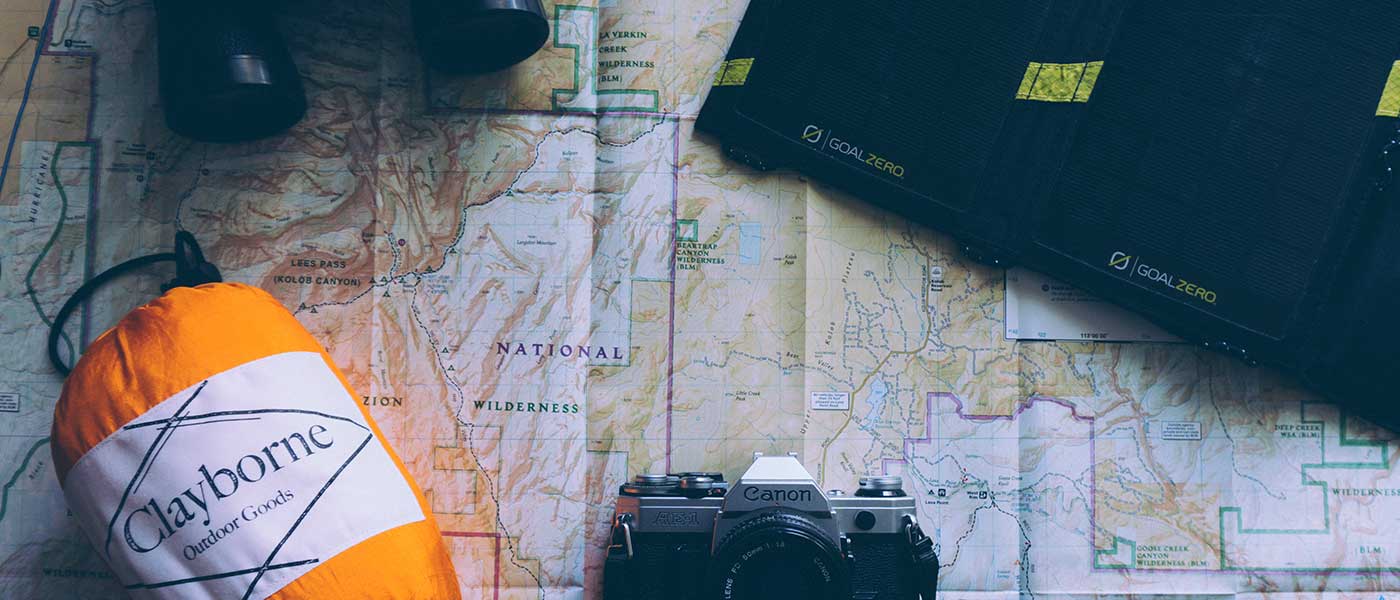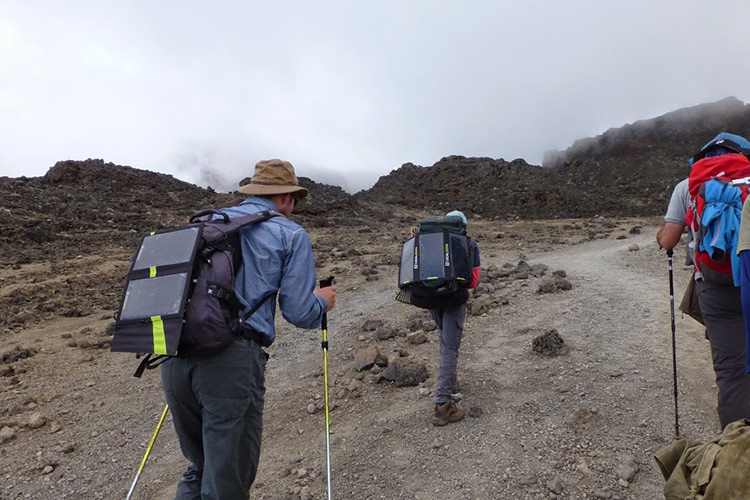Portable solar charger and external mountain battery

Prepare a backpack for an excursion of more than a day or for hiking routes that take you away from home for days or weeks is now done in a completely different way than it was not so long ago. Before, between the basic equipment that every mountaineer should carry in his or her backpack was the first aid kit for emergencies (with sun cream, plasters, iodine, insect repellent and thread and needle to treat blisters), a poncho or mackintosh, warm clothing, a cap or hat, sunglasses and a mat and tent if you are going to sleep outdoors.
In 2007 that would have been enough and you were ready to go. Today, in addition to all of the above - which is still basic and essential on multi-day trips - you add a number of other things gadgets electronic devices, which have become indispensable for everyone. Starting with the smartphone, which is the basic communication tool and the best ally for contacting emergencies, you will probably also carry with you a GoPro type sports camera or even, if you are a photography devotee, you will add an SLR camera or mirror-less to the equipment (the current models mirror-less offer the same performance as a classic mechanical SLR and take up half the space). OK, so now you've got your backpack packed with the basics for 2017 and you can take photos and make calls for a day or two at the most.
Goal Zero nomad 7 solar charger

The problem of charging without plugs
Hiking far from civilisation means there will be no plugs to plug your charger into, nor will you be able to reach for the car's cigarette lighter socket in case you need an emergency charge. Obviously, your phone will always be the most valuable device you carry, since in an emergency it will be what allows you to communicate. If you want to carry your smartphone and several others will require alternative methods: you will need to generate the power for your devices on site or carry it with you to use when you need it. In the first case, a good option is the portable solar charger or the solar battery and in the second the external battery. Sometimes the best option is a combination of both.
A bit of theory
Before moving on to the practical part, it is a good idea to briefly review several electrical concepts - all of which you saw and mastered in high school - that will be very useful to understand the following sections. The key concepts to choose what we need to charge our devices correctly are power measured in watts, W, milliampere per hour or mAh (unit to measure the capacity of a battery) and current in amperes, A.
External batterieswhat to carry and how much
Let's start with battery capacities which, as we have said, are measured in milliamps per hour or mAh. The first thing we need to do is to make a few small calculations of how much capacity we will need to carryby adding the total of capacity which adds up to all the batteries we carry with us.tigo. A smartphone current and high-end devices have a high power consumption, they need a lot of energy to work all day long and the battery will probably not go below 2000 mAh. There are even 4000 mAh batteries. A lower-mid-range phone will probably have a lower capacity battery, around 1000 mAh. Let's assume that your smartphone has a capacity of 2000 mAh.
A GoPro version 3 camera has a battery capacity of 1080 mAh, and we will assume that you carry 2 of them, in total 2160 mAh. Your SLR camera (for example a Fujifilm mirror-less) is powered by a 1260 mAh battery and we will assume that you are also carrying two of them, in total 2520 mAh. The total electrical capacity you are carrying is 6680 mAh. When choosing an external battery this would be the number to pay attention to if you don't want to fall short in capacity.
There are many options for external batteries these days and you can find very compact batteries that fit in the palm of your hand and with capacities of up to 20,000 mAh or more for less than €30, which means charging all the batteries you would carry on your hypothetical excursion about three times. Not bad, right?
How to load it
The next thing to consider is the output amperage (A) or charging intensity of the external battery, i.e. at what intensity the external battery will charge your devices. Each device tolerates different charging intensities and although the manufacturer advises charging with the original charger in your case using a battery this is not going to be possible. Therefore, you should pay attention to the intensity at which the manufacturer recommends charging so as not to reduce the life of the battery.
For low-capacity batteries the recommended current is normally between 1 and 1.5 A, so for your smartphone The lower-mid-range, GoPro batteries and camera batteries should never exceed this figure. The external battery, especially if it has a high capacity and comes from a good manufacturer will offer several outlets for charging at different intensities. If you do not have enough low current charging outlets, connect the one with the highest current to the battery with the highest capacity.
Portable solar chargerWhere will we move?
So far we have only talked about external batteries, but there is also the option of charging our technological instruments through an external battery. solar battery charger. A external battery is crucial if your route will go through shady areas (e.g. an enclosed forest), will take place in winter when light is less intense or in very high latitudes where the sun's rays are less intense. If the route, the time of year and the area offer you the possibility of a lot of light for many hours a portable solar charger or a solar mobile phone charger (if you are only going to bring your beloved smartphone) is a gadget that you must include in your backpack.
When it comes to choosing a solar battery charger it is crucial to take into account not only the total capacity of the batteries you carry in your backpack, but also the power of the solar panel you purchase. This is where the last mentioned quantity comes into play, the power measured in watts (W). The more powerful the portable solar charger more devices you can charge at the same time. A solar battery charger range from 2 to 25 watts of power. With the smallest of them all you can charge just one device - for example your phone - and very slowly, with the largest of them you can charge up to 4 devices all very efficiently and quickly.
Again, as with external batteries, you should try to charge each battery at the amperage intensity recommended by the manufacturer. This is also important for a solar battery charger because normally the more power the solar panels have, the higher the charging current they will be able to provide.
Weight, dimensions and where to use the solar portable charger
Depending on the model of solar battery charger The one you choose will have more or less power and therefore its dimensions will be bigger or smaller. Normally, the largest ones you can find come with several plates that are foldable and do not take up more space than one. tablet, So you can put it in your rucksack without it taking up space or getting in the way. But it is not necessary to put the solar battery charger in your backpack, but many of them have anchors so that you can attach it to your backpack and it will charge your devices while you are walking. That way if you want to charge your devices you don't have to pause along the way to do so.
Divide and conquer
A external battery and a solar battery charger are absolutely necessary if you want to enjoy a hiking experience in complete safety and be able to immortalise key moments in the form of a video or photo. However, they are complementary solutions, so it is best to carry both when you are organising your route. The portable solar charger will not provide great results if the weather is rainy or cloudy, or if for example your route follows a west-east direction and the charger is hanging on your backpack facing in the opposite direction.
On the other hand, the external battery gives you assured charging capacity whatever the weather and whether you're in the middle of the jungle or the forest. Each has its shortcomings and strengths and the key to ensuring you always have enough charge is to buy both. Also, if you want to make sure they work, look for models that are waterproof, dustproof and ruggedised for shock and abuse - there's nothing worse than being left in the wilderness with no charging devices, almost dead batteries and no way to recharge them.
Fastpacking is not about going faster. It's about going lighter.
If you come from classic trekking, this is the next step: learning to move with less weight,
more fluid and enjoying every kilometre more.
Join the channel and start discovering what lightness feels like.
